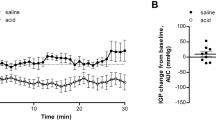Summary
Mucosal mast cells in the rat duodenum show no morphological signs of exocytosis of granules and do not release histamine after treatment with polymyxin B in doses large enough to cause almost complete degranulation of connective-tissue mast cells of tongue, skin, and mesentery with concomitant release of ∼ 60% of the tissue histamine. Administration of polymyxin B in gradually increasing doses over a period of 5ds resulted in a statistically significant increase in mucosal mast cells and a comparable increase in duodenal histamine content, whereas the connective-tissue mast cells in the other tissues examined became fewer in number, the remaining cells showing profound morphological changes, and tissue histamine levels, were reduced to ∼ 40% of the controls. A similar increase in mucosal mast cells has been observed after treatment with another mast-cell secretagogue, compound 48/80. This suggests that the increase in mucosal mast cells may be an indirect effect of these compounds, related to their activation of other mast cells and mediated by material(s) secreted by the connective-tissue mast cells. Possible mediators such as heparin, histamine, and 5-hydroxytryptamine injected for 5 ds in doses large enough to account for the amount released from the degranulated mast cells had no effect on the morphology or numbers of mast cells in any of the tissues examined.
Similar content being viewed by others
References
Andén N-E, Magnusson T (1967) An improved method for fluorometric determination of 5-hydroxytryptamine in tissues. Acta Physiol Scand 69:87–94
Bertler Å, Carlsson A, Rosengren E (1958) A method for the fluorometric determination of adrenalin and noradrenalin in tissues. Acta Physiol Scand 44:273–292
Bhatt KGS, Jalota R, Sanyal RK (1964) Action of various drugs on the tissue histamine and 5-hydroxytryptamine content of common laboratory animals. Indian J med Res 52:52
Bloom GD, Haegermark Ö (1965) A study on morphological changes and histamine release by Compound 48/80 in rat peritoneal mast cell. Exp Cell Res 40:637–654
Enerbäck L (1966a) Mast cells in rat gastrointestinal mucosa. 1. Effects of fixation. Acta Pathol Microbiol Scand 66:289–302
Enerbäck L (1966b) Mast cells in rat gastrointestinal mucosa. 2. Dye-binding and metachromatic properties. Acta Pathol Microbiol Scand 66:303–312
Enerbäck L (1966c) Mast cells in rat gastrointestinal mucosa. 3. Reactivity towards Compound 48/80. Acta Pathol Microbiol Scand 66:313–322
Enerbäck L (1966d) Mast cells in rat gastrointestinal mucosa. 4. Monoamine storing capacity. Acta Pathol Microbiol Scand 67:365–369
Enerbäck L, Löwhagen GB (1979) Long term increase in mucosal mast cells in rat induced by administration of Compound 48/80. Cell Tissue Res 198:209–215
Enerbäck L, Wingren U (1980) Histamine content of peritoneal and tissue mast cells of growing rats. Histochemistry 66:113–124
Fawcett DW (1954) Cytological and pharmacological observations on the release of histamine by mast cells. J Exp Med 100:217–224
Goth A, Johnson AR (1975) Current concepts on the secretory function of mast cells. Life Sci 16:1201–1214
Green H, Erickson RW (1964) Effect of some drugs upon rat brain histamine content. Int J Neuropharmacol 3:315–329
Gustafsson B, Enerbäck L (1980) A cytofluorometric analysis of polymer-induced mast cell secretion. Exp Cell Biol 48:15–30
Horner AA (1971) Macromolecular heparin from rat skin. J Biol Chem 246:231–239
Horner AA (1974) Demonstration of endogenous heparin in rat blood. Adv Exp Med Biol 52:85–93
Jarret EE, Bazin H (1974) Elevation of total serum IgE in rats following helminth parasite infection. Nature 251:613–614
Kremzner E, Wilson I (1961) A procedure for determination of histamine. Biochem Biophys Acta 50:364–367
Lagunoff D (1972a) Contributions of electron microscopy to the study of mast cells. J Invest Dermatol 58:296–311
Lagunoff D (1972b) The mechanism of histamine release from mast cells. Biochem Pharmacol 21: 1889–1896
Lagunoff D (1973) Membrane fusion during mast cell secretion. J Cell Biol 57:252–259
Mota K, Beraldo WT, Junqueira LCU (1953) Protamine-like property of compound 48/80 and Stilbamidine and their action on mast cells. Proc Sco Exp Biol (NY) 83:455–457
Miller HRP (1971) Immune reaction in mucous membranes. II. The differentiation of intestinal mast cells during helminth expulsion in the rat. Lab Invest 24:339–347
Miller HRP, Walshaw R (1972) Immune reactions in mucous membranes. IV. Histochemistry of intestinal mast cells during helminth expulsion in the rat. Am J Pathol 69:195–206
Murray M, Miller HRP, Jarret FH (1968) The globule leucocyte and its derivation from the subepithelial mast cells. Lab Invest 19:222–234
Parrat JR, West GB (1957) Release of 5-hydroxytryptamine and histamine from tissues of the rat. J Physiol (Lond) 137:179–192
Paton WDM (1951) Compound 48/80: A potent histamine liberator. Br J Pharmacol 6:499–508
Riley JF, West GB (1955) Tissue mast cells. Studies with a histamine-liberator of low toxicity (Compound 48/80). J Pathol Bacteriol 69:269–282
Röhlich P, Andersson P, Uvnäs B (1971) Electron microscopic observations on Compound 48/80-induced degranulation in rat mast cells. J Cell Biol 51:465–483
Shore PA, Burkhalter A, Cohn VH (1959) A method for the fluorometric assay of histamine in tissues. J Pharmacol Exp Ther 127:182–186
Wilcoxon F (1947) Probability tables for individual comparisons by ranking methods. Biometrics 3:119–122
Author information
Authors and Affiliations
Additional information
Supported by grants from the Swedish Medical Research Council, Project no 2235
Rights and permissions
About this article
Cite this article
Enerbäck, L., Löwhagen, G., Löwhagen, O. et al. The effect of polymyxin B and some mast-cell constituents on mucosal mast cells in the duodenum of the rat. Cell Tissue Res. 214, 239–246 (1981). https://doi.org/10.1007/BF00249208
Accepted:
Issue Date:
DOI: https://doi.org/10.1007/BF00249208




